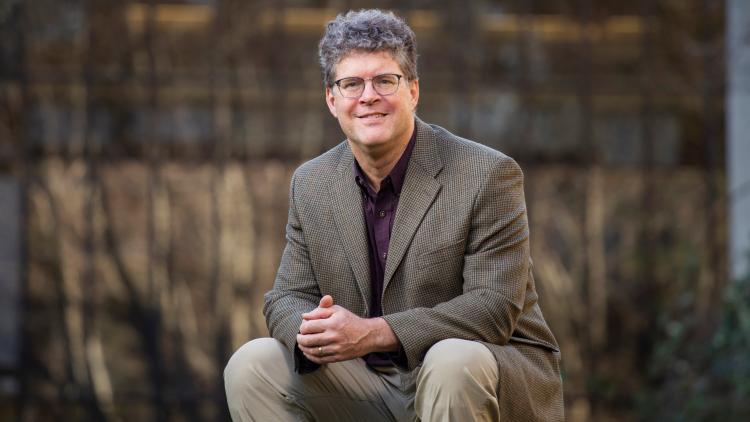Theô Royal Society, a beacon of scientific excellence for centuries, has welcomed Mark Lewis, professor emeritus in the departments ofô mathematical and statistical sciencesô andô biological sciencesô at the University of Alberta, into its distinguished fellowship - placing him among an esteemed group of scientists including Isaac Newton, Charles Darwin and Stephen Hawking. Founded in 1660, the Royal Society is the world's oldest national scientific institution in continuous existence.ô
Lewis, now a faculty member at theô University of Victoria, attributes this rare honour to the many partnerships he has forged throughout his career in the rapidly emerging field of mathematical biology.

Mathematical biologist Mark Lewis has been named a fellow of the Royal Society - placing him among an esteemed group of scientists including Isaac Newton, Charles Darwin and Stephen Hawking. (Photo: Supplied)
"It's an honour and a strong affirmation of the direction of the research, which has been using mathematical models and computer programs to understand questions to do with ecology and anthropogenic disturbance, or human impacts on the environment, that couldn't be understood in any other way," says Lewis.ô
"It's also an affirmation of the collaborative model for doing research. Credit should be given to my collaborators, including the postdocs and graduate students I've trained and worked with over the years."
A self-described "mediocre biology undergrad student," Lewis switched to mathematics and was inspired by epidemiologistô Pauline van den Driessche, his former instructor, to delve into mathematical disease modelling and pursue graduate studies at Oxford. Joining the U of A in 2001 opened up opportunities in other departments and areas of enquiry, specifically in the field of biological sciences, and Lewis was eager to apply his knowledge in new ways.
In biology, the complexity of environmental and human systems and the wide-ranging factors that affect outcomes often require new approaches. Mathematics, he believed, could "pull different levers" and provide fresh insight.
"A mathematical biologist starts with a biological question or hypothesis, puts together equations that we think are describing what's going on and then analyzes these equations, often in collaboration with other people," says Lewis. "Sometimes that means creating entirely new mathematical models."
One of his ongoing collaborators isô Andy Derocher, whose research focuses on polar bears.
"With students I was training, I help quantify the dynamics of polar bear energetics," explains Lewis. "Once we have that in the form of equations, we can make predictions to determine population trends. That's one example and I rely on my network of colleagues to make sure the biology is right."
Before coming to the U of A, Lewis had his first faculty appointment at the University of Utah, where he expanded his postdoctoral research on the formation of territories and wolf behaviour. From polar bears to mountain pine beetle spread, Lewis's fascination with spatial ecology - how organism and habitat arrangement affect ecological processes such as population dynamics, species interactions and the distribution of species - endures to this day.ô
In terms of his biggest research impact, Lewis points to the modelling of population spread of newly introduced or invasive species, which has several facets.ô
"I've worked on equations for this for many years and developed formulas that people now use to understand how quickly species shift into new environments," he says. "These approaches have also been used to look at the response of vegetation to climate change and whether populations in general can keep up with changing climatic conditions. Another facet is the ability to work collaboratively, and that is crucial if you're going to do significant work because it's unlikely that by yourself you'll have all the tools to right the problems that we are facing. It's inherently interdisciplinary."ô
Lewis also takes pride in his role as an educator, especially when he sees the students he trained move forward in their careers.ô
"I teach a course called models in ecology to biology students," he says. "I tell them I am giving them superpowers. They learn to program and do quantitative analysis, and it energizes their research, allowing them to do much more with the data than they could do otherwise. Sharing ideas with my students and working together on projects is where I take the most satisfaction."
Though Lewis has returned to the University of Victoria, his alma mater and the city where most of his family still lives, he maintains a profound and enduring relationship with the U of A. There is ongoing work with Derocher on polar bears and withô Evelyn Merrillô on modelling chronic wasting disease in deer. Other collaborators include fellow mathematiciansô Thomas Hillenô andô Hao Wang. He still supervises several U of A-based graduate students, and he will return to Edmonton in July as co-organizer of theô Society for Mathematical Biology Annual Meeting.
"I'm like a salmon in the river, swimming upstream to home."ô
Lewis joinsô eight previous Royal Society fellowsô from theô Faculty of Scienceô at the U of A, including recent inducteesô Graham Pearsonô andô Rich Sutton.













